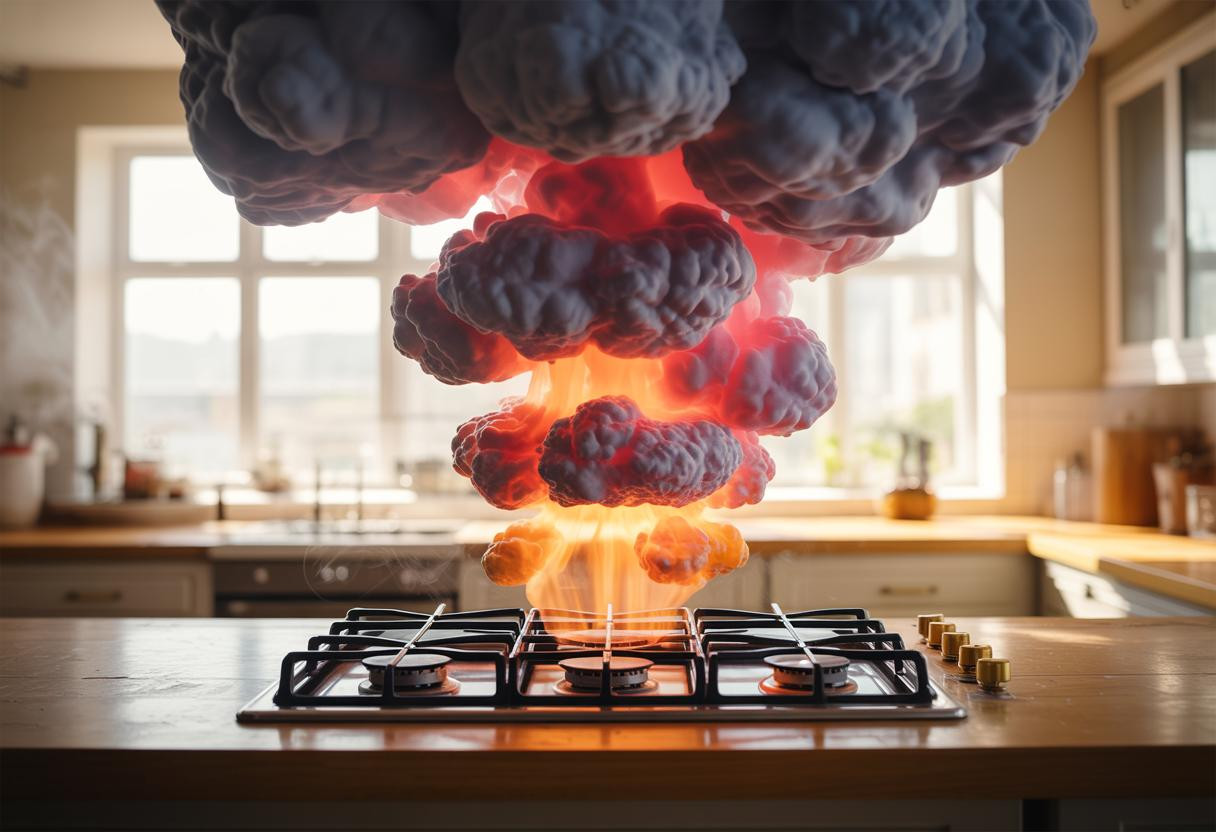Your gas stove could be silently flooding your home with benzene—a known carcinogen—at levels that may increase cancer risk by up to 69 excess cases annually nationwide. Recent 2025 research reveals these kitchen appliances don’t just pollute while cooking; they leak harmful chemicals continuously, creating invisible health hazards that linger for hours after you’ve finished preparing meals.
What makes this discovery particularly alarming is how these emissions spread throughout entire homes, not just kitchens, potentially affecting family members who never even use the stove.
The hidden chemical cocktail poisoning your indoor air
Gas stoves release a dangerous trio of pollutants: nitrogen dioxide (NO₂), methane, and benzene. Stanford researchers found that all 53 homes tested showed methane leaks even when stoves were completely turned off, with leaks accounting for 76% of total emissions.
The most shocking revelation involves benzene exposure. High-emitting gas stoves can spread this carcinogen at concentrations that exceed safety thresholds throughout your home. Children face 1.85 times higher cancer risk from benzene exposure, making this a critical family health concern.
“I didn’t expect to see pollutant concentrations breach health benchmarks in bedrooms within an hour of gas stove use, and stay there for hours after the stove is turned off,” explains Rob Jackson from Stanford’s Doerr School of Sustainability.
Why current safety measures aren’t enough
Ventilation provides false security
Even outdoor-venting range hoods only reduce NO₂ levels by 75%, leaving significant residual risks. Many households don’t use hoods consistently, and pollutants can remain elevated for hours after cooking ends, affecting bedrooms and living areas far from the kitchen.
The childhood asthma epidemic connection
Gas stoves may be responsible for up to 200,000 current childhood asthma cases in the United States. Children in gas stove households are 42% more likely to develop asthma, with nitrogen dioxide exposure alone accounting for one-quarter of these cases. This research mirrors findings about water quality and cognitive health risks in vulnerable populations.
The emerging neurological risk nobody’s discussing
While direct links between gas stoves and cognitive decline remain unproven, the neurological risks from chronic air pollutant exposure create a plausible pathway of concern. NO₂ exposure can induce oxidative stress, potentially triggering neuroinflammation that affects brain function over time.
Benzene’s carcinogenic properties may intersect with epigenetic mechanisms crucial for neurodevelopment, particularly concerning for children whose brains are still forming. Recent studies on neurological brain rewiring research highlight how environmental factors can significantly impact cognitive health.
Immediate protection strategies you can implement today
Maximize ventilation effectiveness
Always use outdoor-venting range hoods during cooking and keep them running for at least 30 minutes afterward. Open windows to create cross-ventilation, especially during extended cooking sessions.
Consider strategic appliance replacement
Switching to electric or induction stoves eliminates combustion emissions entirely. Induction cooking offers superior energy efficiency and precise temperature control while protecting your family’s health. This approach mirrors other kitchen safety and cancer risks mitigation strategies.
Deploy air quality monitoring
Install low-cost sensors to track NO₂ and carbon monoxide levels in real-time. This data helps you understand your family’s actual exposure and adjust cooking habits accordingly.
The surprising truth about indoor air quality
Your kitchen may be more polluted than busy city streets during peak cooking hours. Unlike outdoor air quality, which has strict regulations, indoor air standards remain virtually nonexistent for pollutants like NO₂ and benzene from gas appliances.
Consider supplementing ventilation improvements with indoor air quality improvement solutions that can help reduce overall pollutant levels throughout your home.
Why this knowledge changes everything
Understanding these risks empowers you to make informed decisions about your family’s health. While complete elimination requires appliance replacement, immediate steps like improved ventilation and cooking habit modifications can significantly reduce harmful exposures starting today. Your awareness transforms a hidden danger into a manageable health decision.
